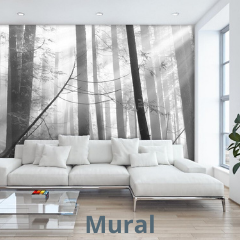What is the difference between a wall mural and wallpaper?
The BIGGEST Difference
The biggest difference between a wall mural and wallpaper is how you use murals. With wall murals, you usually only apply it to just one feature wall in a room whereas with wallpaper, you would apply to more than one wall, sometimes applying it to all four walls. However, there are still many differences between murals and wallpaper that many people tend to not realize. Luckily for you, we go over these main differences to help you decide what is right for your next home décor adventure!
1. Murals are generally applied to just one feature wall in a room
2. Murals are built with different materials
3. Murals can be completely customizable
4. Murals are meant to make a statement or create an impact
5. Murals create an opportunity to give a room more depth
6. Each mural tells a continuous story
7. Wallpapers are mass produced whereas murals are more eco-friendly
8. Murals are sold by the panel and wallpapers are sold by the roll
9. The application process is different
10. Murals have different lifespan and care requirements
1. Murals are generally applied to just one feature wall in a room
Wall mural ideas and inspirations can be found all over the internet and social media such as Instagram. However one common mural idea that seems to unite all onlookers is that an impactful mural needs to applied to the feature wall in a room. To draw a more apparent comparison, please take a gander at the following:


As you may see with the wall mural, it serves as a statement piece in the room whereas the wallpaper is actually taking a back set by honing the focus towards the bedroom décor.
2. Murals are constructed with different materials
The great news about murals is that they are typically printed on the highest quality of photo paper. This is to ensure that the mural is easy to clean (of which we go over later on this blog) and that the image is crisp and pixel perfect. Murals and wallpapers can sometimes be built using the same materials but there are some materials that are uniquely used for murals. And those are the following:
- Photo paper
- Canvas
- Perforated window film
- Polyester or Mylar
Then this following list is a list of materials used to construct both wallpapers and murals:
- Lining paper
- Cellulose
- Grasscloth
- Vinyl-coated paper or fabric
- Vinyl
- Velvet-flocked paper
- Foil
- Non-woven
Now I know exactly what you are thinking: which wallpaper material is the one used in Grandma's house? Well that would most likely be the wallpaper made out of cellulose because most traditional wallpapers used cellulose in the past as their leading material base.
The wall mural materials that we use boast the following features:
- Our mural paper is the highest quality blend of the finest wood pulp and polyester fibers
- Our mural paper is biodegradable
- Our mural paper is eco-friendly and eco-ethically sourced
- Our mural paper is Mildew and bacteria resistant
- Our mural paper is Fire Resistant
- Our mural paper is made without any plastic materials such as vinyl
The good news with murals is that they offer a more diverse selection of materials to work with so what that means for you is that you get more options to fine tune your choice in order to achieve the effect that you want. And if you're unsure, you are more than welcome to reach out to us!
3. Murals can be completely customizable
Ever taken a picture and felt that "WOW!" factor so much so that it deserves to be on display in your home? Well wall murals offer the flexibility to take any stellar photos that you have saved digitally right into your home.
This customization quality allows our Canadian artists a lot of freedom when they are designing wall murals because it encourages them to flex their creative muscles since they don't have to worry about designing something "too large" or "too small". We have the digital finesse to assist our local artists in a way that doesn't impede upon their creative processes.
4. Murals are meant to make a statement or create an impact
If you want to make a space feel larger and more luminous then murals are definitely the way to go because they enhance a greater sense of depth, creating a Trompe L'oeil effect. 
One of the best ways to make a statement wall in a room is to write down the top 3 feelings that you want to feel when you look upon your statement wall. And then just go with the feeling! If you want to feel bewildered then perhaps a more bewildering image should be your focus or perhaps you could incorporate a fun optical illusion? And statement walls don't have to be chaotic either! The choice is all yours.
5. Murals create an opportunity to give a room more depth
Want to make a room larger without having to reconstruct your entire room? Well murals can make a room seem larger by giving it more depth. The reason why murals can achieve this over wallpaper is that murals are typically printed using high quality prints on high quality material. Depending on the image and the way the light hits your room, these murals can reflect more natural light evoking a sense of openness and space.
6. Each mural tells a continuous story
Ask yourself: do you want the story of your room written on the walls? If the answer is "yes" then a wall mural may be very well be a top choice for your room. Wall murals are suppose to tell a story whereas wallpapers are meant to be a backdrop for the rest of the room.
7. Wallpapers are mass-produced whereas murals are more eco-friendly
Mass production involves producing a large quantity of wallpapers to then get shipped over to different retail locations. Then when these wallpapers don't sell, what happens is that they end up getting recycled or thrown out. The production, shipping, and eventual waste of the unsold wallpapers contributes a lot to increasing their carbon footprint.
Here at Mod Design, we are happy to inform you that we only produce and ship to our customers on a per order basis. This saves us from shipping larger quantities of murals to a location in hopes that they would sell. And in the end, this reduces our carbon footprint and allows us to feature a wide arrange of local Canadian artists.
8. Murals are sold by the panel and wallpapers are sold by the roll
As wallpaper is sold in rolls, murals are sold in panels. As such, each mural panel must tell a story. Each wall mural panel is fitted as a straight match to complete the entire scene. Therefore when shopping for a wall mural, you won't have a little extra leftover roll to work with.
This is why it is important to carefully measure the wall you want to adorn with a mural. And it's also why we suggest reaching out for a consultation on what you'd like to purchase. We are honestly just an email away!
9. The application process is different
What makes applying a wall mural different from applying a wallpaper is that when you are applying a wall paper you have to cut the wallpaper to fit your room. Whereas when you apply a wall mural, instead you will be working with panels that are measured to fit the wall you wish to apply it to.
We do have more detailed instructions on how to apply a wall mural, so you are more than welcome to check out our instructions. And of course, if you have questions about a project in mind then you can certainly reach out to us as well! We would love to get excited with you about any future mural plans!
10. Murals have different lifespan and care requirements
Both wallpapers and wall murals can have long lifespans but the catch is that you have to take care of them properly. These different care requirements are going to vary depending on the materials that were used to construct the wall mural; specifically those materials that are sensitive to moisture damage. For wall murals and wall papers that are sensitive to moisture, try brushing the surface with a soft cloth or a duster to remove any dust.
Avoid using harsh cleaners, like bleach, as it can damage the material and distort the wall mural. As mentioned earlier, our wall murals are mildew resistant so you can clean like you would with any other regular wall so long as you aren't using any harsh cleaners.
